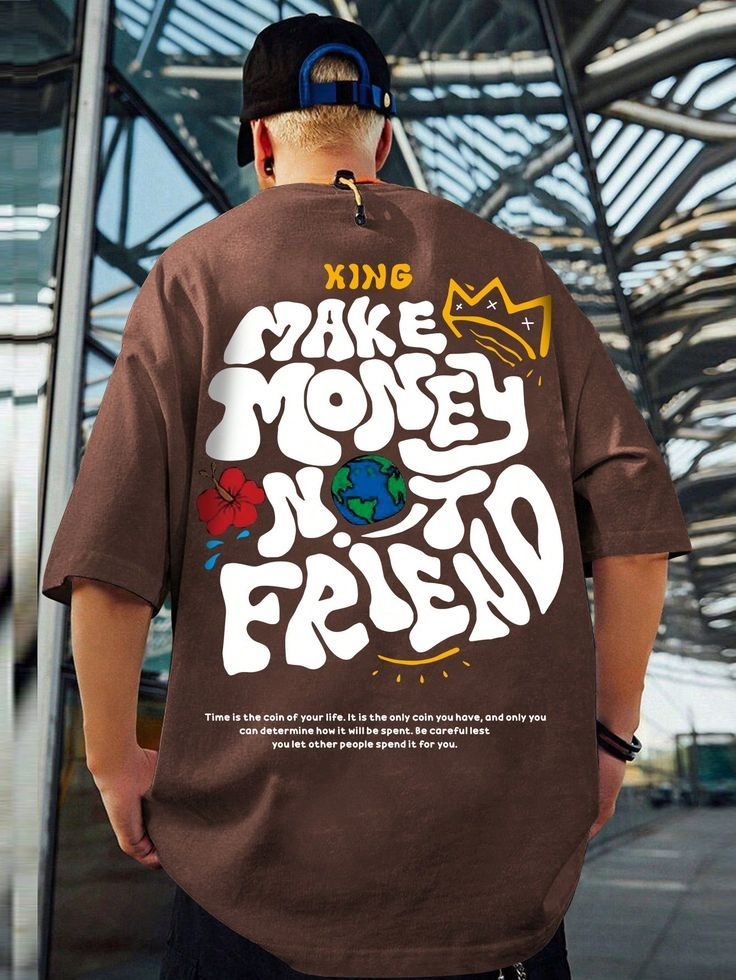Currently Empty: $0.00

The history of the T-shirt traces its roots to practical needs and social changes that reshaped the garment into a fashion statement. Initially, the T-shirt began as an undergarment, serving as a lightweight option for soldiers during World War I. Before this period, most men wore heavy, uncomfortable woolen shirts that were not well-suited for the hot, humid conditions of war. The U.S. Navy introduced the cotton T-shirt in the early 1900s to provide a more breathable, comfortable option. This new design became widely accepted among soldiers, who appreciated its convenience and practicality.
By the 1920s, the T-shirt was adopted by civilian workers as well. It was lightweight, inexpensive, and easy to care for. However, it wasn’t until the 1950s that T-shirts began to transcend their humble origins. Actors like James Dean in Rebel Without a Cause and Marlon Brando in A Streetcar Named Desire popularized the T-shirt as a symbol of youthful rebellion and individuality. The simple, plain white shirt became a fashion statement, associated with a sense of freedom and nonconformity.
The 1960s marked the beginning of the graphic T-shirt revolution. As youth culture emerged in the postwar era, T-shirts became a canvas for expressing personal interests, political beliefs, and artistic styles. The first printed T-shirts often featured bold slogans, logos, or images related to political movements or pop culture. The 1970s saw the rise of band T-shirts, which allowed fans to show support for their favorite musical acts, further cementing the T-shirt’s place as an essential part of casual style.
Through the 1980s and 1990s, graphic T-shirts evolved into a key component of streetwear culture, where urban youth often used clothing as a form of expression. T-shirt design became a powerful means for self-expression, social commentary, and identity, allowing people to make statements through the clothes they wore.
In recent years, T-shirts have continued to evolve with technological innovations. Digital printing and direct-to-garment printing have allowed for more intricate designs and customization options. T-shirts today are not only about style but also comfort, performance, and even sustainability.
Types of T-shirts
The variety of T-shirts available today is astounding, with designs and styles that cater to nearly every preference. Here are some of the most common types of T-shirts:
- Basic T-shirts
The classic, plain T-shirt is an essential staple in any wardrobe. Made from simple cotton or cotton blends, basic T-shirts are often solid-colored and unadorned. They serve as an ideal layering piece or can be worn on their own for a minimalistic, timeless look. Basic T-shirts come in various fits, including regular, slim, and relaxed, and are often considered one of the most versatile clothing items. - Graphic T-shirts
Graphic T-shirts are an essential way to communicate personal interests, affiliations, and creativity. Whether adorned with iconic logos, slogans, artistic prints, or abstract designs, these T-shirts allow for a high degree of personalization. Over the years, graphic T-shirts have been adopted by youth subcultures, music fans, political movements, and fashionistas. They’ve become an integral part of expressing individuality through clothing. - Designer and Luxury T-shirts
As fashion evolved, so did the desire for higher-end T-shirts. Designer T-shirts, made from premium fabrics and featuring intricate designs, have become a status symbol. Luxury T-shirts are typically characterized by unique cuts, embroidery, and the logo of a well-known fashion house. They are often made from materials such as fine cotton or silk blends, and they come with price tags that reflect their exclusivity and craftsmanship. - Performance T-shirts
T-shirts designed for athletic use are made from fabrics that offer performance enhancements, such as moisture-wicking, quick-drying, and UV-protection properties. These T-shirts are often worn by athletes or during exercise, as they help keep the body cool and dry. Some performance T-shirts are made with advanced synthetic materials like polyester, spandex, or nylon, which help in stretching and moisture control. - Sustainable and Eco-friendly T-shirts
In response to growing concerns about sustainability and environmental impact, many companies have started producing eco-friendly T-shirts. These are made from organic cotton, bamboo, hemp, or recycled materials, aiming to reduce the carbon footprint of textile production. Ethical production methods also focus on reducing waste, using natural dyes, and ensuring fair labor practices. - Vintage and Retro T-shirts
Vintage T-shirts, which evoke nostalgia, have gained popularity in recent years. These shirts often feature logos or designs from previous decades, such as concert tour shirts from the 1980s or T-shirts with logos from old-school brands. Retro T-shirts celebrate past trends and are often sought after for their uniqueness or rarity. Many people collect vintage T-shirts as fashion statements or as pieces of memorabilia.
Materials Used in T-shirt Manufacturing
The fabric of a T-shirt plays a significant role in its comfort, appearance, and durability. Several materials are commonly used in T-shirt production:
- Cotton
Cotton is the most widely used fabric for T-shirts, prized for its softness, breathability, and natural feel. Cotton is an all-natural, renewable resource that allows the skin to breathe, making it comfortable for everyday wear. However, traditional cotton farming is resource-intensive, requiring large amounts of water and pesticides, which has led to the rise of organic cotton, grown without synthetic chemicals or fertilizers. - Polyester and Blends
Polyester is a synthetic fabric known for its durability and moisture-wicking properties. When blended with cotton, it creates a fabric that is less prone to wrinkling, more resistant to shrinking, and quicker-drying. Polyester-cotton blends are often used in performance T-shirts or those designed for activewear, as the fabric moves moisture away from the body, keeping the wearer dry during exercise. - Organic and Sustainable Fabrics
With the rise of environmental consciousness, there has been a shift towards using more sustainable materials in T-shirt production. Organic cotton, which is grown without harmful pesticides or synthetic fertilizers, is one such material. Other sustainable options include bamboo, which grows quickly and requires minimal water, and hemp, known for its durability and eco-friendly cultivation. - Innovative Fabrics
Recent advances in fabric technology have led to the development of high-performance materials, such as moisture-wicking fabrics, UV-protective materials, and T-shirts made from recycled plastic bottles. These innovations have created new opportunities for sustainable fashion, allowing designers to create T-shirts that are not only stylish but also environmentally friendly.
T-shirt Design and Printing Techniques
The art of designing and printing T-shirts has evolved with technological advances. Today, there are multiple methods to create unique T-shirt designs:
- Screen Printing
Screen printing is one of the oldest and most popular methods for transferring designs onto T-shirts. It involves creating a stencil or screen of the design and using it to apply ink onto the fabric. This method is ideal for bulk printing and is commonly used for large runs of T-shirts with simple or solid designs. - Direct-to-Garment (DTG) Printing
DTG printing is a newer technology that allows for high-resolution images to be directly printed onto fabric using inkjet technology. Unlike screen printing, DTG printing can produce complex, full-color images with fine details, making it ideal for designs with gradients, photos, and intricate artwork. This method is often used for smaller orders or custom T-shirt designs. - Heat Transfer Vinyl (HTV)
In heat transfer vinyl printing, a design is cut from a vinyl sheet and then applied to the T-shirt using heat and pressure. This technique is popular for custom T-shirt designs, sports team jerseys, and personalized clothing. It’s particularly durable, as the vinyl adheres tightly to the fabric. - Embroidery and Patches
For a more refined, textured design, embroidery is used to stitch patterns, logos, or artwork onto a T-shirt. Embroidery adds a layer of texture and luxury, often used by designer brands for logos and unique touches. Patches, which are similar to embroidery, are sewn or heat-pressed onto the shirt and can be removed or swapped out. - Fabric Dyeing and Techniques like Tie-Dye
Another creative way to design a T-shirt is through fabric dyeing. Tie-dye, one of the most iconic dyeing techniques, creates colorful patterns by folding, twisting, or tying the fabric before applying dye. This method was particularly popular during the 1960s and has made a strong comeback in recent years as part of retro and bohemian styles.

